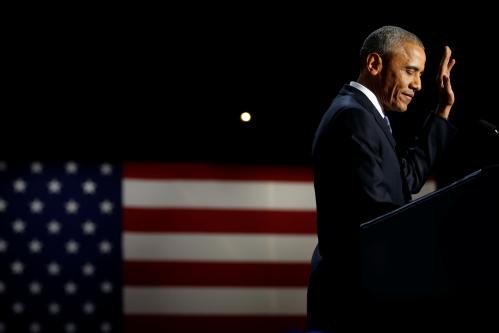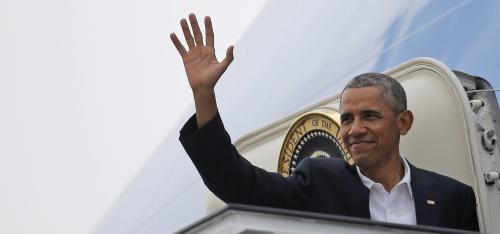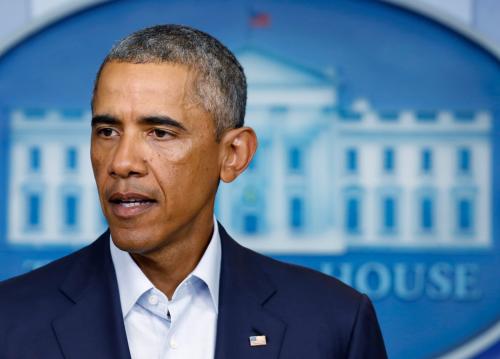This originally appeared in the Boston Review.
It becomes clearer every day that Barack Obama, a historic president, presided over a somewhat less than historic presidency. With only one major legislative achievement (Obamacare)—and a fragile one at that—the legacy of Obama’s presidency mainly rests on its tremendous symbolic importance and the fate of a patchwork of executive actions.
How much of that was due to fate and how much was due to Obama’s own shortcomings as a politician is up for debate and is a question that emerges from Princeton historian Julian Zelizer’s new edited volume, The Presidency of Barack Obama.
With contributions from seventeen historians, the book bills itself as “a first historical assessment” of the Obama presidency. The overwhelming consensus, Zelizer writes, is that Obama “turned out to be a very effective policymaker but not a tremendously successful party builder.” This “defining paradox of Obama’s presidency” comes up again and again: the historians, by and large, approve of Obama’s policies (although some find them too timid) while they lament his politics.
The politics were pretty disastrous. As Zelizer summarizes, “During his presidency, even as he enjoyed reelection and strong approval ratings toward the end of this term, the Democratic Party suffered greatly. . . . Democrats lost more than one thousand seats in state legislatures, governors’ mansions, and Congress during his time in office.” Zelizer could have gone further. According to Ballotpedia, more Democratic state legislative seats were lost under Obama than under any president in modern history.
Yet even with such political fallout, the overall tone of the book is surprisingly wistful. Or perhaps it is unsurprising when you notice that it was written shortly after the 2016 election. The contributors, like the nation, were shell-shocked by the results, and the book, which has a few strong chapters, suffers from the sting of Donald Trump’s victory—after which it became difficult to say anything negative about a normal president.
As such, the book frequently makes excuses for Obama. As Zelizer says in the very first chapter, “The President could take Speaker of the House John Boehner out to play as much golf and drink as much bourbon as their hearts desired, but it wouldn’t make one iota of difference.” Some of the contributors likewise treat Obama’s political problems as if Obama had nothing to do with them, and in so doing they tend to absolve Obama himself from any responsibility for them.
This sort of benefit-of-the-doubt thinking, however, does not produce very insightful history. True, playing golf and drinking bourbon would not alone have changed the composition of the Republican caucus, but it would have given the president a better idea of what he was up against. Moreover, it caricatures what really happened: Obama was not just distant from the Republicans in Congress—he was distant from the Democrats as well. His reluctance to engage members of Congress cut across the aisle, with many Democrats just as furious as Republicans. This would only occasionally break out into the press, but it was well known on the Hill.
So while it is true that Obama faced an extremely oppositional Republican Party, historians must not ignore the fact that Obama was a distant politician. In the end, he was more concerned with policy and reluctant to engage in the political battles that make for successful and sustainable policy.
This flaw is evident in one of the book’s best essays. In “Neither a Depression nor a New Deal,” Eric Rauchway describes the Obama presidency’s “original sin, ” its response to the Great Recession.
Rauchway recounts how Christina Romer, the first chair of Obama’s Council of Economic Advisors, came up with a number ($1.8 trillion), “based on arithmetic and data,” that she thought would be necessary to jumpstart the economy again. Given the sense of emergency at the time and the Democratic control of both houses of Congress, Obama could have used his rather large amount of political capital to authorize and then fight for a larger stimulus package, one which focused intensely on job creation and retention. But the star economist on his team, Lawrence Summers, disagreed with Romer and argued that the economy could be stabilized using a much smaller stimulus. Obama chose to go with Summers’s plan; the results of that decision would reverberate throughout his presidency.
First of all, while Summers’s plan worked, the recovery was very slow. Second, instead of focusing relentlessly on jobs, as Romer, most of Congress, and most of the nation wanted, the administration quickly pivoted to its next policy agenda item: health care. As Rauchway writes, “Obama’s decision to deemphasize stimulus in favor of pressing for health insurance reform was a gamble of immense, if unknowable, magnitude and consequence.”
By 2010 Obama’s fate was sealed. In the midterm elections, Republicans ran on the slow recovery, the perception that the stimulus package favored Wall Street, not Main Street, and the Democrats’ tone-deaf obsession with the health care bill. They easily took control of the House, picking up sixty-three seats—the biggest midterm election gains for the out party since 1938. And from then on, the Obama presidency struggled under a radicalized Republican Party. As Paul Starr writes in the collection, “Obama repeatedly chose substance over politics, which hardly seems like a fault in a president—except that the failure to get credit later limited what he was able to do.”
And so for its remaining six years, the Obama presidency had to confront a Republican Party that was hell-bent on opposing everything he did. But was such opposition set in stone?
At its height, the House Republican Tea Party Caucus consisted of only 60 members out of 242 Republican members of Congress. That left 182 Republicans to be wooed by a new and charismatic Democratic president—far fewer than what was needed to break gridlock. But a president who would not court members of his own party was not likely to try or to be successful at courting members of the other party, either.
In the summer of 2010, for example, Obama tried to pass a comprehensive cap-and-trade bill to combat climate change. It failed miserably, and after that, climate change legislation “fell off the political radar,” according to Meg Jacobs. It was replaced by an aggressive strategy of executive actions, from the Clean Power Plan to the Paris climate accords. And yet, as Jacobs concludes, “With the election of Donald Trump in 2016, many of Obama’s advances became vulnerable to rollback by the new GOP president who believes climate change is a ‘hoax.’”
Indeed, as Zelizer’s volume makes clear, the problem with executive action is that it is so easily undone. The majority of the book is spent cataloging Obama’s many well-intentioned executive actions that are in the process of being reversed by his successor.
Obama, for instance, presided over a Justice Department that made meaningful gestures toward reducing incarceration and demanding accountability for police violence. But these moves can be undone by the current attorney general, Jeff Sessions, leaving Peniel E. Joseph to characterize this part of the Obama legacy as “an opportunity found and frustratingly lost for advocates of criminal justice reform.” Writing about Obama’s urban policy, Thomas J. Sugrue calls Obama’s actions “miniscule” and “too cautious” and notes that, “In Obama’s last two years in office, American cities began to burn again.”
Obama’s most significant executive action came as the result of his failure to pass comprehensive immigration reform. As Sarah R. Coleman notes, “In the summer of 2012, under pressure from party activists to show some effort on immigration reform before the November election and unable to rise above the partisanship that dominated Washington as he had hoped, President Obama turned to his executive powers and announced the creation of the Deferred Action for Childhood Arrivals (DACA) program.” But again we see the weakness of executive action. As Coleman concludes, “President Obama ends his two terms with few successes and a mixed legacy on immigration and refugee policy.”
Of course there were successes in the Obama administration that appear to be sustainable. The fact that the Affordable Care Act escaped congressional repeal by the skin of its teeth is one bright spot in an otherwise dreary picture, even though the Trump administration continues to undermine it at every step. And as Timothy Stewart-Winter points out, Obama will likely be remembered as the “Gay Rights President,” in honor of the astonishing progress toward LGBTQ rights made during his years in office.
But as this first accounting of the Obama presidency shows, a president’s policy legacy is indistinguishable from his political legacy. Meaningful, sustained progress on policy requires some continuity in the political base. Rather than remake the Democratic Party from top to bottom, Obama opted to focus his political hopes on the continued success of his campaign, Obama for America. Writing in this volume, Michael Kazin notes, “Organizing for America (OFA), the group Democrats created just before the inauguration to harness the momentum of the Obama campaign to their legislative program, failed to keep the party’s young, multicultural base mobilized against the Republican onslaught that followed.”
The Presidency of Barack Obama is a good example of how hard it is to write history quickly. In twenty or so years, we may well discover that Obama’s distance from politics was intentional and designed to preserve an image of the president as “above politics.” As we know from Fred Greensteins’s book on President Dwight D. Eisenhower, The Hidden Hand Presidency: Eisenhower as Leader (1982), Eisenhower intentionally obscured his acute political sense. But his “above it all” approach to the presidency did not change what was the liberal, New Deal trajectory of the country any more than Obama changed the conservative, anti-government zeitgeist.
In the end there are only two ways a president can forge a legacy in U.S. politics: accomplish things with bipartisan support, or nurture his political party so that people are elected who will carry on and protect his accomplishments. Obama’s legacy is in trouble because he did neither. For him, the first path was difficult—and some would say impossible. He faced a Republican Party controlled by extremists determined to undermine him at all costs. “It’s one of the few regrets of my presidency,” he said in his last State of the Union address, “that the rancor and suspicion between the parties has gotten worse instead of better. There’s no doubt a president with the gifts of Lincoln or Roosevelt might have better bridged the divide, and I guarantee I’ll keep trying to be better so long as I hold this office.”
That left him a second path: build a Democratic Party strong enough to carry on his accomplishments. Though he did not do so at the time, Obama’s current pledge to nurture a new generation of leaders(through his foundation) and his support for former Attorney General Eric Holder’s campaign to fight gerrymandering are signs that he has come to the realization that his legacy depends on politics after all. It is a late realization but, given that the fifty-six year old has many years of influence before him, perhaps his post-presidency will help build the political support for the kinds of policies he advocated as president.








Commentary
The fragile legacy of Barack Obama
April 6, 2018